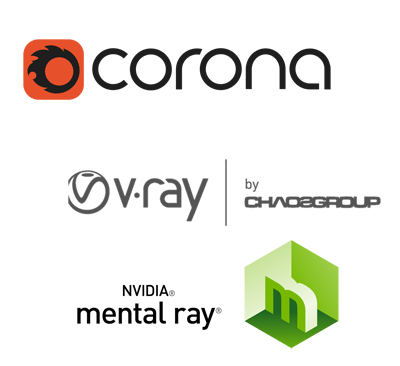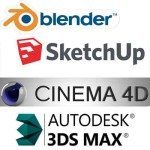Best Rendering Engines for 3D Visualization
The process of 3D visualization is based on the usage of three-dimensional graphics and goes within several stages – designing a 3D model of the object, the scenery of the environment, texturing, setting the optimal level of lighting, selection of the camera’s angle and selection of effects and 3D rendering.
Choosing the right rendering engine can depend on various factors including the required level of realism, hardware constraints, personal or studio proficiency with the tool, and the specific visualization needs of a project. Often, professionals have experience with multiple renderers to cater to diverse project requirements.
- V-Ray: Developed by Chaos Group, V-Ray is a versatile and widely-used rendering engine that offers both CPU and GPU rendering. It’s known for its photorealistic outputs and integrates with software like 3ds Max, Cinema 4D, Maya, SketchUp, and Rhino.
- Industries: Architecture, Product Design, Film & TV
- Strengths: High-quality photorealistic renders, extensive material library, robust lighting options.
- Integration: 3ds Max, Maya, Blender, SketchUp, Rhino, Revit
- Usage: Offline Rendering
- Corona Renderer: Also developed by Chaos Group, Corona is known for its user-friendly interface, efficient rendering processes, and impressive light calculations. It’s often used for architectural visualizations.
- Industries: Architecture, Product Design
- Strengths: Ease of use, interactive rendering, physically accurate.
- Integration: 3ds Max, Cinema 4D
- Usage: Offline Rendering
- Unreal Engine: Though originally a game engine developed by Epic Games, Unreal Engine has found favor among architectural and product visualization professionals because of its real-time rendering capabilities. The introduction of ray tracing in Unreal Engine 4 further pushed its adoption in the visualization community.
- Industries: Gaming, Film & TV, Architecture
- Strengths: Real-time rendering, highly interactive, excellent for VR and AR, large community.
- Integration: Standalone, but assets can be imported from multiple software.
- Usage: Real-Time Rendering
- Arnold: Developed by Solid Angle (now owned by Autodesk), Arnold is a ray-tracing renderer known for its flexibility and strength in handling complex scenes. It’s commonly used in VFX and feature-length animations, integrating with software like Maya and Cinema 4D.
- Industries: Film & TV, Visual Effects, Animation
- Strengths: High-quality rendering, good for complex lighting and scenes, physically accurate.
- Integration: Maya, 3ds Max, Cinema 4D, Houdini
- Usage: Offline Rendering
- Redshift: This is a GPU-accelerated, biased renderer known for its speed. Redshift offers integrations with tools like 3ds Max, Cinema 4D, and Maya.
- Industries: Film & TV, Product Design, Architecture
- Strengths: GPU accelerated, known for fast rendering times, highly customizable.
- Integration: Cinema 4D, Maya, 3ds Max, Houdini
- Usage: Offline Rendering
- OctaneRender: Developed by OTOY, OctaneRender is a popular GPU-rendering engine known for its fast rendering times and real-time capabilities. It supports multiple 3D modeling platforms.
- Industries: Film, Animation, Product Design
- Strengths: GPU accelerated, real-time viewport preview, photorealistic renders.
- Integration: Cinema 4D, Blender, Maya, 3ds Max, Houdini
- Usage: Offline Rendering
- RenderMan: Developed by Pixar Animation Studios, RenderMan is a high-performance rendering engine known for its role in producing Hollywood blockbusters. It’s known for its advanced features and high-quality results.
- Cycles: This is the built-in renderer for Blender, an open-source 3D software. Cycles offer both CPU and GPU rendering and is praised for its versatility and integration with Blender’s toolset.
- Industries: Animation, Product Design, Architecture
- Strengths: Open-source, integrated tightly with Blender, GPU acceleration, good for both photorealistic and stylized rendering.
- Integration: Blender
- Usage: Offline Rendering
- Lumion: Popular among architects and designers for architectural visualization, Lumion offers real-time rendering capabilities and a large library of assets. It’s user-friendly and produces fast results.
- Enscape: Used mainly for architectural visualization, Enscape integrates with software like Revit, SketchUp, Rhino, and ArchiCAD to provide real-time 3D walkthroughs with a VR option.
- Unity
- Industries: Gaming, Industrial Simulation, Architecture
- Strengths: Versatile, good for mobile and web-based applications, user-friendly, large community.
- Integration: Standalone, but assets can be imported from multiple software.
- Usage: Real-Time Rendering
Each engine has its own set of features, strengths, and weaknesses, and the “best” engine for you will depend on your specific needs, the software you’re using, and your familiarity with the rendering process. Keep in mind that the landscape for rendering engines is continually evolving, and newer engines or updates to existing engines might offer capabilities that were not available as of my last update.
Our choice
Chaos Group V-ray www.chaosgroup.com
Among the modern rendering programs, the external program of visualization named VRay, developed by Chaos Group, is in great popularity. The reason is that the program for the calculation uses only the most advanced computing techniques and is based solely on the method of Monte Carlo. Besides that, the program includes a lot of interesting, innovative technologies and solutions that allow one to perform all the calculations quickly and accurately. V-Ray is available as a plug-in for Maya 3ds max, Rhino3D, SketchUp, and Cinema 4D.
VRay is not so demanding to the geometry as other similar applications, for example, programs that use radiosity, so it is very important to analyze initially and to fix the geometry of the scenery before starting the rendering process.
Thanks to VRay, global illumination can be adjusted, resulting in the improvement of photorealistic scenes that are created. You can use different algorithms required for imaging calculations to display the global illumination – Photon Map, Light Cache, and Irradiance Map.
It is worth noting that VRay is well known in all areas of visualization thanks to a pretty large arsenal of different tools required for integration.
Among the main advantages of the given program are the ability to distribute rendering on multiple PCs, the addition of procedural tools and textures in 3ds MAX, which may ease the work with the scenery. It is worth noting the presence of different algorithms, flexible settings and materials that can accurately reproduce the properties of the objects.
Corona Renderer www.corona-renderer.com
Corona Renderer is a new photorealistic renderer, fully integrated into the 3ds MAX, designed by Ondra Karlík in 2009. This render actively develops and supports more and more functions, while having high stability at large postproductions.
Corona renderer is a relatively young rendering system and still has a limited number of possibilities, but even on the eve of the release is capable of solving complex problems. Corona is confidently used in architectural visualization and object visualization. Gradually it goes into the area of TV production.
Stunning visuals, lightning speed, and enviable simplicity, along with the free, outdated, but still excellent version of Alpha6, Corona renderer is simply an irreplaceable tool for any visualizer!
Mental Ray www.nvidia-arc.com
This graphics software is a professionally integrated system of visualization and rendering from the German studio named Mental Images (a branch of the Nvidia corporation).
Mental ray is a powerful rendering technology used in many software products of industrial design and creation of digital content, such as Autodesk, Autodesk Maya, and Solidworks.
The application supports the technology of distributed rendering, thanks to which rationalization and equal distribution of computing on PCs come, supporting the segmented visualization.
The program allows generating images of the very highest quality, to create realistic visual effects, harmoniously combining all the latest technologies of computer programming and lighting.
The function of the built-in volume shadowing, as well as the method of final gathering, are the necessary tools by means of which a natural look of the frame is achieved without the use of additional settings.
In addition, this app is equipped with a diverse set of tools that allow to simulation of multiple light reflections of elements in the scene (Global Illumination) and allow calculate accurately the parameters of the level of lighting to create realistic effects when objects are moving.
- How to add perspective to architectural projects with digital 3D rendering help - December 24, 2023
- 3D Architectural Walkthrough Animation Services New York - April 24, 2019
- 3D Rendering Services in San Francisco, California - March 12, 2019









